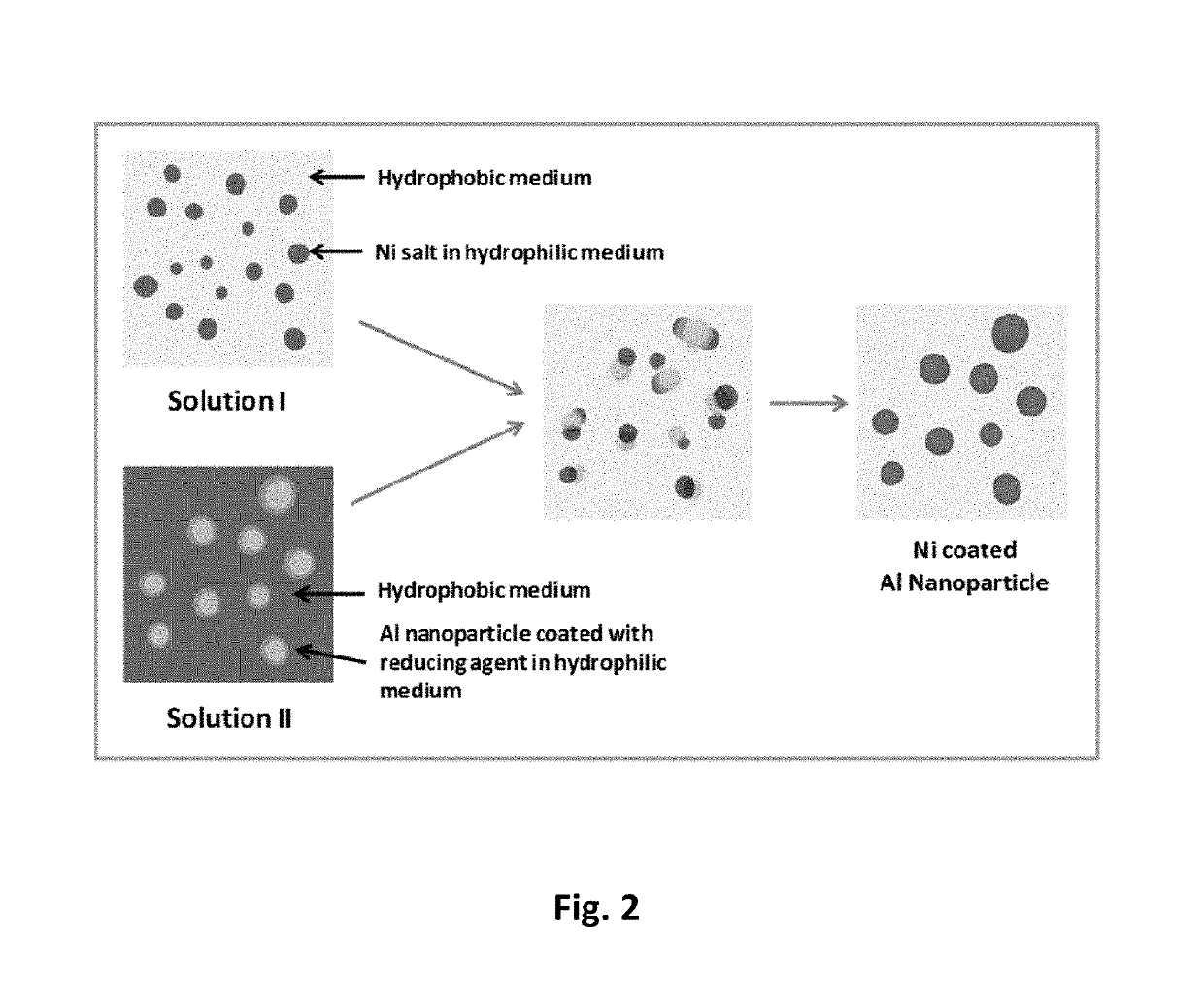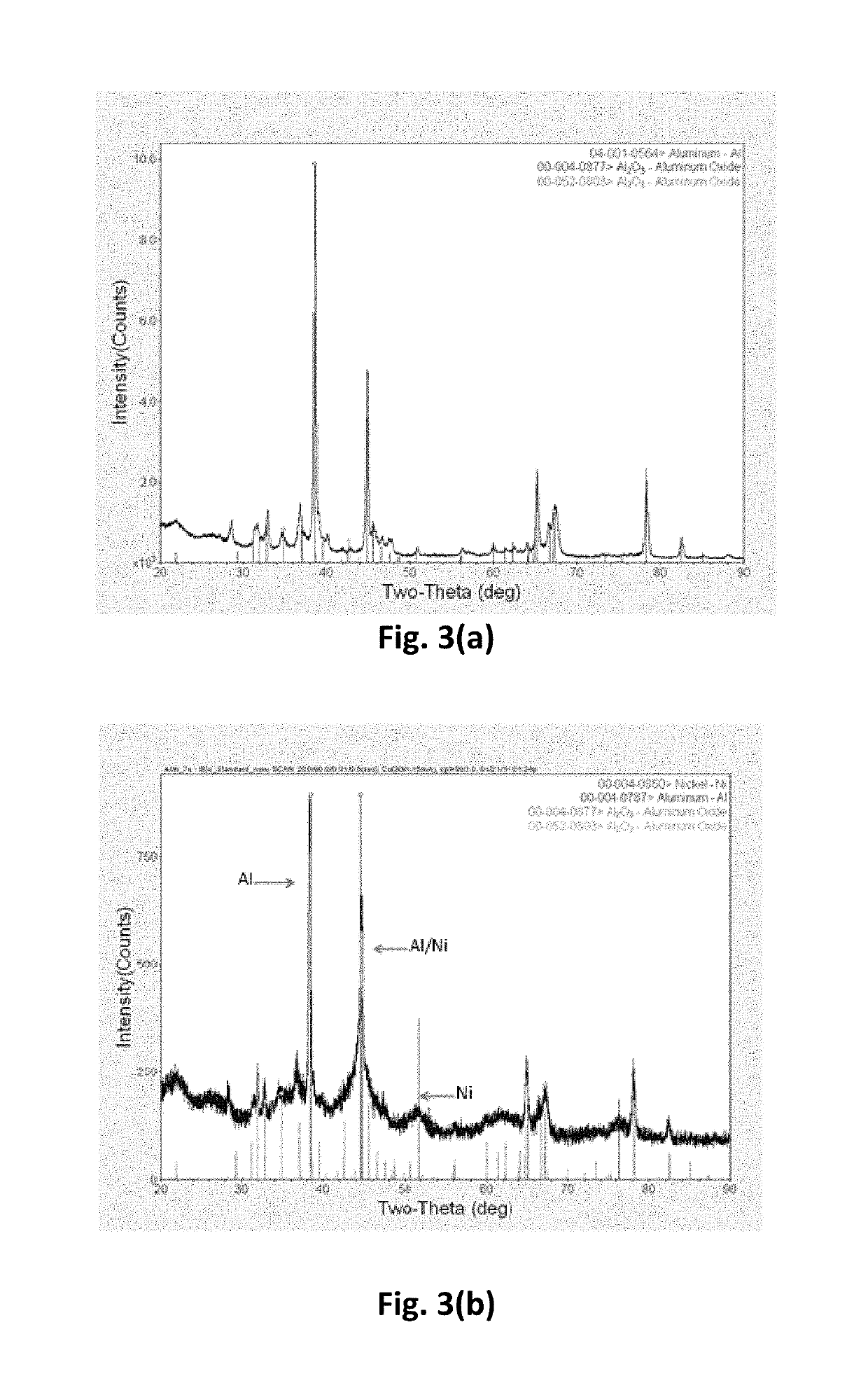Metal-metal boride-metal based core-shell particles and a method to produce the same
- Summary
- Abstract
- Description
- Claims
- Application Information
AI Technical Summary
Benefits of technology
Problems solved by technology
Method used
Image
Examples
example 1
for Preparing Aluminum-Nickel Core-Shell Nanoparticles
[0026]In this invention we disclose a new solution based process, which is a combination of reverse micelle and electroless deposition methods. The chemical process essentially consists of using two separate solutions, one that contains Ni2+ ions, and the other a reducing agent to convert Ni2+ to Ni0 (elemental nickel). FIG. 2 shows a schematic of the process. Solution 1 is a microemulsion, where the nickel salt is dissolved in a hydrophilic medium such as a water / hexanol mixture to form reverse micelles and it is subsequently dispersed in a hydrophobic medium such as cyclohexane. The hydrophobic medium can be an aromatic or an aliphatic molecule. Solution 2 is a microemulsion, where aluminum nanoparticles coated with a reducing agent such as sodium borohydride is dispersed in a hydrophilic medium such as a water / hexanol mixture to form a reverse micelles and it is subsequently dispersed in a hydrophobic medium such as cyclohexan...
example 2
for Preparing Aluminum-Aluminum Boride Core-Shell Nanoparticles
[0033]Conventional methods require high temperatures (>750° C.). However, this is not feasible for energetic applications as this will lead to the loss of the nanoparticle nature of aluminum due to the low melting point of aluminum (mp 660° C.). However, in a solvothermal synthesis method, high pressure and mild temperature (<250° C.) in a solvent can lead to reactions, which would otherwise require high temperatures.
[0034]The solvothermal reactor used for the experiments is able to withstand 30 MPa of pressure and 300° C. temperature. Initially, 2.3 g of BI3 was dissolved in 125 mL of hexanol, followed by the addition of 0.4 g of aluminum nanoparticles, and 0.4 g of sodium metal (from 40 wt % sodium metal dispersion in kerosene). The mixture was stirred for 30 minutes and subsequently poured in to the reactor, under inert atmosphere. The reactor was heated to 215° C. and 12 MPa of pressure. A 12 MPa pressure caused the ...
example 3
for Preparing Aluminum-Aluminum Boride-Nickel Core-Shell Nanoparticles
[0040]The aluminum-aluminum boride-nickel core-shell nanoparticles were synthesized by initially synthesizing aluminum-aluminum boride core-shell nanoparticles, using the method described in Example 2. Subsequently, the aluminum-aluminum boride core-shell nanoparticles were coated with nickel, using the method described in Example 1. FIG. 12 shows a schematic of the synthesis process used in this work. Initially, aluminum particles are mixed with sodium and boron iodide in solvent such as hexanol. The mixture is treated in the solvothermal reactor to in-situ form aluminum boride on the surface of aluminum particles. The treated powder is filtered and washed with alcohol and vacuum dried to remove the volatiles. Subsequently, the aluminum-aluminum boride powder is coated with nickel, using the process described in Example 1. The aluminum-aluminum boride powder is first dispersed in a mixture of hexanol and water th...
PUM
 Login to View More
Login to View More Abstract
Description
Claims
Application Information
 Login to View More
Login to View More - R&D
- Intellectual Property
- Life Sciences
- Materials
- Tech Scout
- Unparalleled Data Quality
- Higher Quality Content
- 60% Fewer Hallucinations
Browse by: Latest US Patents, China's latest patents, Technical Efficacy Thesaurus, Application Domain, Technology Topic, Popular Technical Reports.
© 2025 PatSnap. All rights reserved.Legal|Privacy policy|Modern Slavery Act Transparency Statement|Sitemap|About US| Contact US: help@patsnap.com



